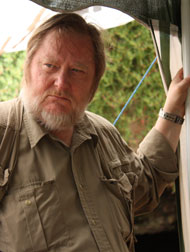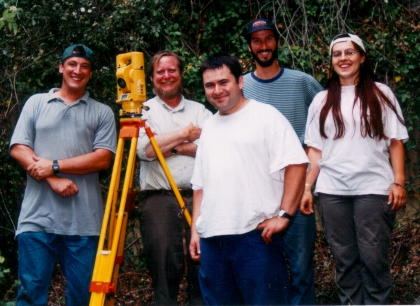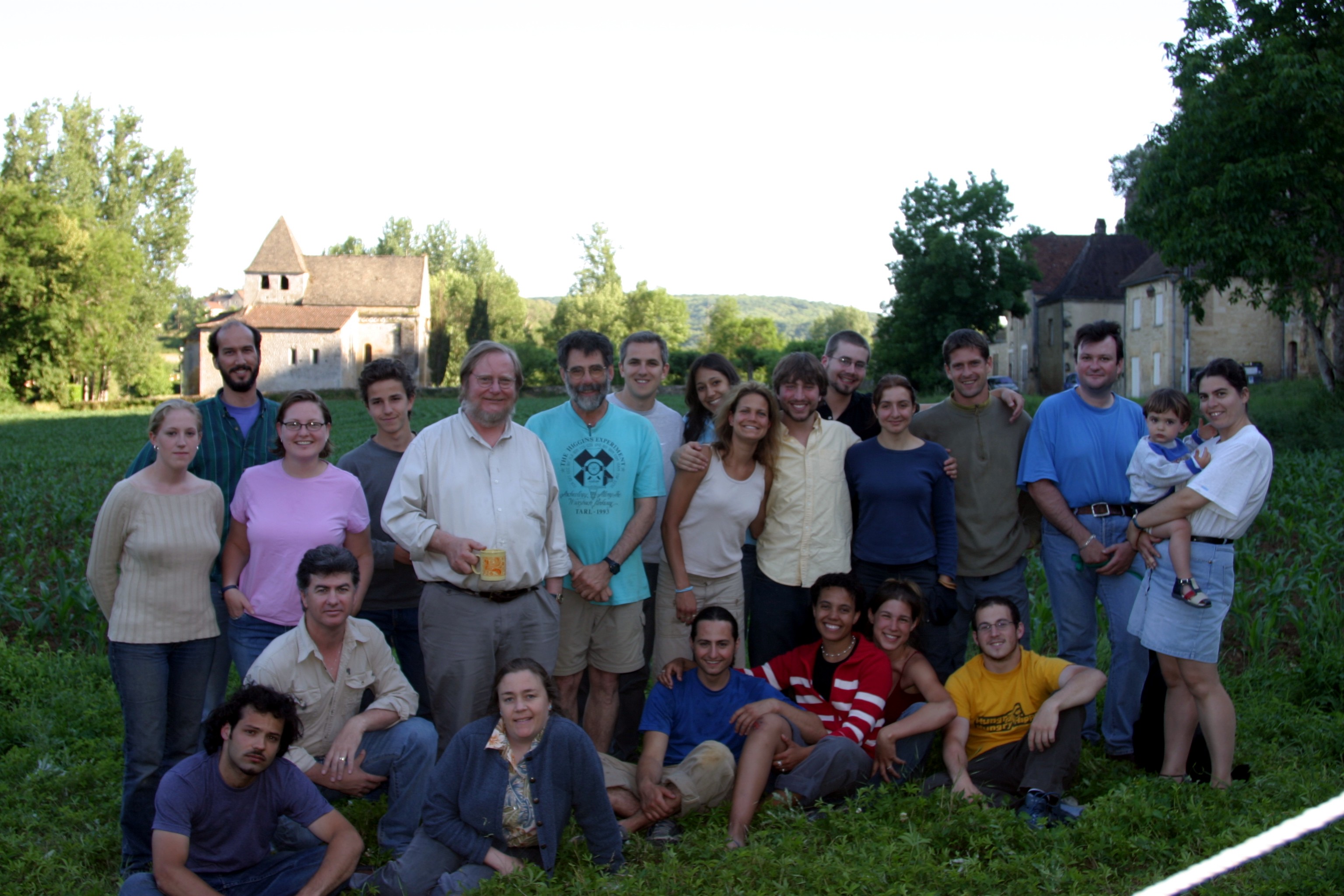Harold Dibble
Created by: Steven Burkhalter

Biography
Harold Dibble was born on July 26, 1951. He recieved his Bachelors of Arts in 1971 from the University of Arizona and went back to University of Arizona a few years later to do his graduate studies and recieved his Ph.D in 1981. While in grad school, he studied under a professor Arthur Jelinek who worked on the paleolithic of Western Eurasia and the Mimbres Culture in New Mexico. During Graduate school, he was a part of many different excavations including a site called Pech De I'Aze in France. He currently works as a professor of Anthropology at the University of Pennsylvania where he has worked on hundreds of different papers.
His current research interests include Archaeology of course, specializing in the middle paleolithic of Western Europe, Egypt, and the Near East. He is currently the project director of Excavations at Pech de l'Azé IV (Where he did his dissertation during graduate school) and Roc de Marsal in France, and the Abydos Survey for Prehistoric Sites in Egypt. Harold is also currently working on issues of plestocene hominid behavioral evolution; computer applications to archaeological fieldworld and analysis; lithhic technology, typology, and experimentation (such as NewPlot, EDM-CE and EDM Windows, and E4). (Dept of Anthropology University of Pennsylvania)
Excavation Sites and Projects
Pech de l'Azé
Pech de l'Azé is a very important project that Dibble is currently the project director of. During graduate school, Dibble worked on his dissertation for the University of Arizona on this very site. The site started as a four year project to re-excavate what had already been excavated and look at new and different ways to analyize and date the site. Level 8 of this site contains abundant evidence of Neandartal use of fire which is something Dibble specializes in studying.
Back in the summer of 1996, Harold Dibble and Shannon McPherron were given authorization by Institute de Préhistoire et de Géologie du Quaternaire and Mme. Bordes to excavate the site with modern descriptions and analysis. This project had three main goals: Organize and maintain the collection before the loss of documentary evidence would lessen its value for research, to make the information that Bordes collected over 8 years public, and to use the information collected here to draw new conclusions concerning Middle Paleolithic systematics and adaptation. (The New Project at Pech de I'Azé)
Along with the collection project they realized there would need to be a new excavation would need to occur before the sites information could be published. In 2000, they began this new excavation to re-sample the site with a few initial goals. First, they wanted to complete the geological descriptions of the sequence. Second, they wanted to study site formation processes and obtain dates. Finally, they wanted to collect new samples to assess the degree to which the existing collection had collection bias.

Roc De Marsal
Roc de Marsal is a Middle Paleolithic cave in Dordogne, France near Les Eyzies. Excavation started with Jean Lafille until he passed away in 1971. Fossilized remains of Neandertal infants were found in what looked to be an intentional burial and this sparked Dibble's interest in the area because of his focus in plestocene hominid behavioral evolution. In early 2003 a multi-year excavation project was started in order to obtain new samples and artifacts to understand and date the site. They laid out five different objectives of the project in Roc de Marsal which included: complete exposure of the combustion features in the lower levels, dating and excavation of the pit or cavity, continued sampling of the lower levels, continued analysis of the lithic collections, and finally continued analysis of the faunal collections.
The Neandartal burial was very important in his research. When it was discovered in 1961, the child was found in a pit dug into the bedrock. Because it was found in bedrock, it was interpreted as a deliberate burial. After the discovery of the child burial site, all of the sediment was removed and sent to Institut de Paléontologie Humaine in Paris. This made it much harder for Dibble and his associates to study the context of the burial site because all that's left now is a hole of bedrock and an empty excavation pit. In 2005, 3 teeth were found at the site but none had any relationship with the original skeleton. (OldStoneAge.com - Paleolithic Research on the Web)

Abydos Survey for Paleolithic Sites
As well as working on the Roc de Marsal and the Pech de l'Azé sites, Harold Dibble worked with the Penn Museum on the Abydos Survey for Paleolithic Sites in Egypt. This project surveyed the high desert near Abydos which is about 450 km south of Cairo, Egypt. They were looking for Paleolithic artifacts from between 500,000 to 10,000 BP with most of their emphasis on the Middle Paleolithic time peroid between 240,000 and 45,000 BP. Dibble worked closely with Deborah I. Olszewski, Shannon P. McPherron, and Jennifer R. Smith on this survey project. They used detailed artifact analysis, the study of landscape formation in the desret, and systematic archaeological survey to accomplish their goals of surveying while focusing mainly on the Middle Paleolithic. They focused on this time peroid because this was when the first "modern" human left Africa to colonize the rest of the world. The goal of this project was to provide new data on the ways in which the landscape was used and to try and compare and contrast moderm human strategies to early modern human behaviors. (Penn Museum)
They worked from 2000 to 2007 on surveying different portions of the high desert of Egypt near the site of Abydos. They concluded that previous formal and informal research and survey work resulted in rich archaeological resources of historic and prehistoric periods. A Belgian survey in the 1970s established the presence of Paleolithic occurences immediately surrounding historic Abydos. During the course of the seven years of this project, they completed three different field seasons to intensively survey area. They surveyed from right next to Abydos to as far as 20 kilometers into the high desert. They discovered rich records of Paleolithic use of the area. (OldStoneAge ASPS)
Well Known Works
Middle Paleolithic Symbolism: A Review of Current Evidence and Interpretations
As stated above, one of Harold Dibble's main research focuses is working on the issue of plestocene hominid behavioral evolution. In this paper, Harold talked about homonids in the middle paleolithic and how they used planning and foresight for survival by extensively manipulating the world around them. He used the presence of materials from far sources to justify their use in certain tasks like hunting to separate them from other primates of the time. It also described their ability to care for one another and how important that was in the survival of their species during that time. This work is one of his most sited works as it has been sited 326 recorded times according to (Google Scholar).
Middle Paleolithic Scrapper Reduction: Background, Clarification, and Review of the Evidence to Date
As well as working on the middle paleolithic homonid behavior, Harold was also very important in the development of the theory of scraper reduction. Scraper reduction is the idea that Middle Paleolithic people were subject to retouching and their scraper types represent different stages of reduction from blank to exhausted scraper with the intensity of reduction correlating strongly with the availability of raw material. In this paper, he reported six different points to support Middle Paleolithic scraper morphology. The scraper morphology being a reflection of intensity of utilization and degree of resharpening and rejuvination, coupled with aspects of blank size and shape. His first point was that Ethnographic data shows that continous reduction is a common aspect of lithic technology in modern groups utilizing stone technology. His second point was that lithic morphology variability is tied to resharpening and reduction. The third point said a directed analysis of the scrappers from Biache show patterns in the application of retouch which demonstrate the continuous nature of hte processes that resulted in the different types of classes. The fourth point stated that the direct, metric evidence for middle paleolithic scraper reduction, gathered by several independent researchers, is overwhelmingly supportive of these models. Fifth, he stated the undeniable connection between specific kind of reduction sequence and blank shape across a large geographic and temporal spread. And finally, the middle paleolithic assemblages reflect together the effects of intensity of utilization. All six of these points boil down to a considerable amount of support for Dibble's scrapper reduction model.Acting and Archaeology
According to IMDB , Harold acted has acted in two different films throughout his career. In 2002 he acted as himself in an episode of the TV series documentary Modern Marvels called Axes, Swords, and Knives. Also in 2002 he acted as himself again in another TV documentary called NOVA. The episode of NOVA was titled Neanderthals on Trial where he spoke about his work with Neanderthals
Axes, Swords, and Knives. Modern Marvels
History channel produced a documentary on the uses, necessity, and history of sharp cutting blades such as axes, swords, and knives. Harold can be quoted saying, "Basically it's the one thing that we have no natural part of our body that can serve that purpose; that is, to slice things up, to cut things." (4:12-4:27). He then goes on to explain what is important to look at in assemblages of stone flakes and why the context on how they were made greatly impacts the importance or information behind what the tools were used for. He also says, "The difference between a chipped piece of flint and a knife is basically nothing." This helps others understand how hard it is to figure out if it was actually a tool or the by-product of making a tool. The idea behind flint-knapping or scrapper reduction relates to how Harold supported his scrapper reduction theory in early paleolithic Neanderthal tool building processes. Modern Marvels: Deadliest and Most Useful Tools: Axes, Swords, and Knives - History Documentary
NOVA
In the episode of NOVA, Dibble can be quoted saying, "The big word is compassion. They were able to show compassion on the part of Neanderthals. You've got a flower burial. That's a very compassionate act. And then you've got this indivudal with a withered arm that wasn't able to fend for himself, therefore the clan is coming around him and supporting him and so forth." Harold then goes on to explain how there are two different types of individuals, people who perceive Neanderthals as being dumb, and those who perceive Neanderthals as being smart. The two differeing viewpoints on Neanderthals has created a polarization in the field. He explains that the people who believe Neanderthals were dumb because they couldn't speak and their behavior was very primitive compared to ours. And the others who think Neanderthals were smart argue that they were a, "...human technology. Primitive language, but still very much a human language with human culture...". The fact that there are two differing viewpoints leaves little room for people to have an opinion between the two. NOVA Transcrips
Computers and Archaeology
Harold and some of his co-workers have been developing programs and computer applications to help aid and assist in bringing computers and technology into the archaeological world.
NewPlot
New plot is an interface that is used to display data from SPEC files. NewPlot allows you to find peaks in a scan, It's very fast and has simple fitting routines available. (NewPlot)EDM and EDM-CE
EDM and EDM-CE are both programs that are used to collect data using Total Stations and Windows programs.E4
E4 is another data collection program that they developed to help with artifact analysis.References
Image 1. https://leakeyfoundation.org/event/2016-trip-to-france/
Image 2. http://www.oldstoneage.com/pechiv/images/crew98.jpg
Image 3. http://www.oldstoneage.com/rdm/images/crewphoto2004.jpg
1. ASPS. ASPS. N.p., n.d. Web. 14 Apr. 2016. http://www.oldstoneage.com/abydos/default.shtml
2. Background. Background. N.p., n.d. Web. 14 Apr. 2016. http://www.oldstoneage.com/rdm/background.shtm
3. Chase, Philip G., and Harold L. Dibble.Middle Paleolithic Symbolism: A Review of Current Evidence and Interpretations. Journal of Anthropological Archaeology 6.3 (1987): 263-96. Web.
4. Deadliest and Most Useful Tools: Axes, Swords and Knives - History Documentary. Youtube. History Chanel: Modern Marvels. n.d. Web. 22 Apr. 2016. https://m.youtube.com/watch?v-W8qyFDsHbiE
5. Department of Anthropology. Department of Anthropology. N.p., n.d. Web. 04 Apr. 2016.
6. Dibble, Harold L.. “Middle Paleolithic Scraper Reduction: Background, Clarification, and Review of the Evidence to Date. Journal of Archaeological Method and Theory 2.4 (1995): 299–368. Web...
7. The European Synchrotron. N.p., n.d. Web. http://www.esrf.eu/Instrumentation/software/beamline-control/BLISS/BLISS-Applications
8. Google Scholar. N.p., n.d. Web. https://scholar.google.com/citations?user=R02xCTgAAAAJ&hl=en
9. IMDB Profile: http://www.imdb.com/name/nm2430460/
10. "Neanderthals on Trial" PBS> PBS, N.d. Web. 22 Apr. 2016. http://www.pbs.org/wgbh/nova/transcrips/2902neanderthals.html
11. Pech IV. Pech IV. N.p., n.d. Web. 14 Apr. 2016. http://www.oldstoneage.com/pechiv/collection_project.shtml
12. The Penn Museum.Penn Museum. N.p., n.d. Web. 14 Apr. 2016. http://www.penn.museum/research/projects-researchers/egyptian-section/120-abydos-survey-for-paleolithic-sites-asps

